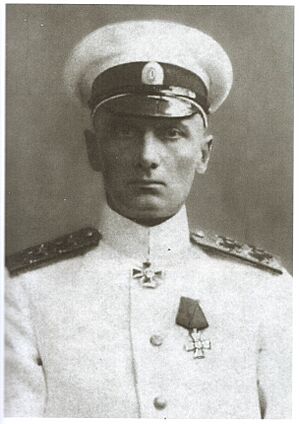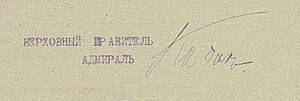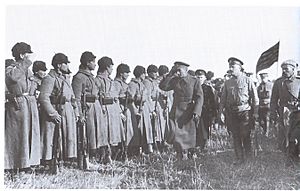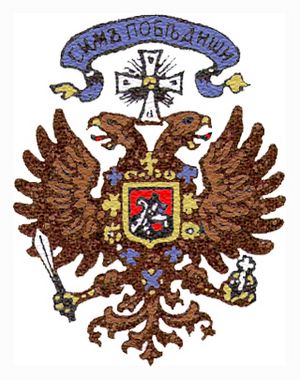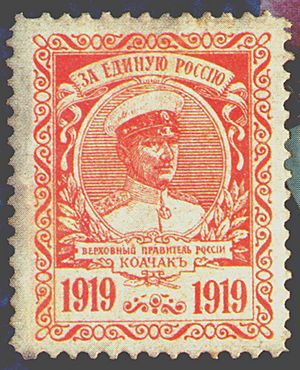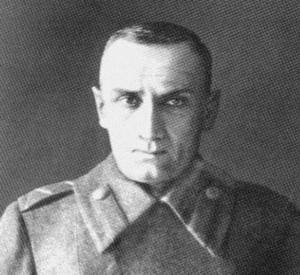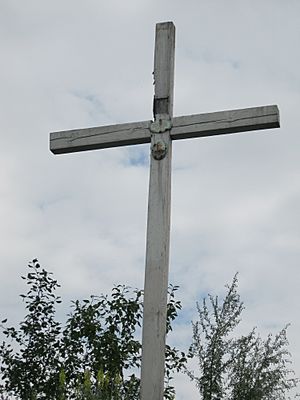Alexander Kolchak facts for kids
Quick facts for kids
Alexander Kolchak
|
|
|---|---|
| Александр Васильевич Колчак | |
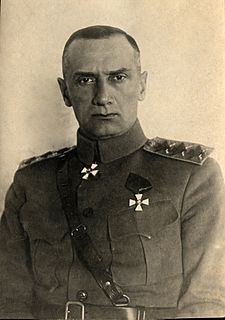
Kolchak in 1919
|
|
| Supreme Ruler of Russia | |
| In office 18 November 1918 – 7 February 1920 |
|
| Preceded by | Position established (Nikolai Avksentiev as Chairman of the Provisional All-Russian Government) |
| Succeeded by | Anton Denikin (de facto) |
| Personal details | |
| Born | 16 November 1874 Saint Petersburg, Russian Empire |
| Died | 7 February 1920 (aged 45) Irkutsk, Russian State |
| Spouse | Sophia Fedorovna Omirova Kolchak |
| Children | Rostislav Kolchak |
| Military service | |
| Allegiance |
|
| Branch/service |
|
| Years of service | 1886–1920 |
| Rank | Admiral (from 1918 Onward) |
| Battles/wars | Russo-Japanese War World War I Russian Civil War |
Alexander Vasilyevich Kolchak (Russian: Александр Васильевич Колчак; November 16, 1874 – February 7, 1920) was a Russian admiral and military leader. He was also a polar explorer, meaning he explored the cold Arctic regions. He served in the Imperial Russian Navy and fought in two major wars: the Russo-Japanese War (1904–1905) and World War I (1914–1918).
During the Russian Civil War (1917–1922), Kolchak led a group called the "White movement." This group was against the communists, known as the Bolsheviks. He set up an anti-communist government in Siberia and was recognized as the "Supreme Leader" of all Russian land and sea forces from 1918 to 1920. His government was based in Omsk, a city in southwestern Siberia.
For almost two years, Kolchak was seen by other countries as the head of Russia. However, he struggled to unite the White Movement. He didn't want to give ethnic minority groups their own power and didn't work with other non-Bolshevik groups. Instead, he looked for help from foreign countries. This made the Bolsheviks stronger because they could say Kolchak was just a "Western Puppet."
As his White forces became weaker, he was captured in December 1919 by Allied military leaders and the Czechoslovak Legion. They handed him over to local Socialist-Revolutionaries in January 1920. Soon after, the Bolsheviks executed him in February 1920 in Irkutsk.
Contents
Biography
Alexander Kolchak was born in Saint Petersburg, Russia, in 1874. His family came from Romania. His father was a retired military officer who had fought in the siege of Sevastopol and later worked as an engineer.
Kolchak decided to join the navy. He graduated from the Naval Cadet Corps in 1894. He first served in Vladivostok in the Russian Far East from 1895 to 1899. Later, he returned to western Russia and joined a polar expedition in 1900. He worked as a hydrologist, studying water and ice, on a ship called the Zarya.
After a difficult journey, Kolchak returned in December 1902. The leader of the expedition, Eduard Toll, and three other explorers were lost. Kolchak took part in two more Arctic trips to search for them, but they were never found. Because of his explorations, he was sometimes called "Kolchak the Polar." He received the Constantine Medal, a very important award from the Imperial Russian Geographical Society.
In December 1903, Kolchak was about to get married when he heard that Russia was going to war with Japan. He quickly got married and then went straight to Port Arthur to fight. In the early part of the Russo-Japanese War, he served on a cruiser ship and later commanded a destroyer called Serdity. He helped lay naval mines, which are bombs placed in the water. One of his mines sank a Japanese cruiser. He was given an award for his bravery.
As the war continued, he commanded a coastal artillery battery, which is a group of cannons on the coast. He was injured during the final battle for Port Arthur and became a prisoner of war in Nagasaki, Japan. He was sent back to Russia early because of his poor health. When he returned, he received another award, the Golden Sword of St. George, for his bravery.
After the war, Kolchak helped rebuild the Imperial Russian Navy, which had been badly damaged. He worked on plans for new ships and training programs. He also helped design special icebreaker ships called Taimyr and Vaigach. These ships were used for mapping expeditions in the Arctic. Kolchak commanded one of these ships and later wrote an important study about ice in the Arctic seas. In 1912, he joined the Russian Baltic Fleet.
First World War
When World War I started in 1914, Kolchak was on a ship called Pogranichnik. He helped set up many defensive minefields along the coast. He also planned attacks on German naval bases. Kolchak believed that the person who planned the attacks should also take part in them, so he often joined the ships during these dangerous night operations.
In August 1916, he was promoted to vice-admiral, becoming the youngest person to reach that rank. He was put in charge of the Black Sea Fleet. His main job was to help the Russian army fight against the Ottoman Empire. He also worked to stop German submarines and planned an invasion of the Bosporus, though this never happened. Kolchak's fleet successfully sank Turkish coal ships, which caused problems for the Ottoman government because they needed coal for their capital city. In 1916, Kolchak's fleet helped the Russian army capture the city of Trebizond.
One sad event during his time was when the battleship Imperatritsa Mariya exploded in port in October 1916. It was never fully clear if it was an accident or sabotage.
Revolution and Civil War
After the February Revolution in 1917, the Black Sea fleet became very disorganized. Kolchak was removed from his command in June and went to Petrograd. He spoke to the Provisional Government and told them that the Russian military was losing its strength. He believed the only way to save the country was to bring back strict discipline.
Many people who wanted a strong leader saw Kolchak as a possible future dictator. Some secret groups even asked him to lead them. When the government found out about these plans, they sent Kolchak to America. He was supposed to share information with the American Navy. However, by the time he arrived, the Americans had changed their plans. Kolchak decided to return to Russia through Japan.
The October Revolution (when the Bolsheviks took power) happened in November 1917 while Kolchak was in Japan. In December, he offered his help to the British. He was asked to go to Harbin to take command of Russian troops there. The British hoped these troops could help overthrow the Bolshevik government and get Russia back into the war against Germany.
On his way, Kolchak arrived in Omsk, Siberia. He agreed to become a minister in the White Siberian Regional Government. He was seen as an important figure because he had the respect of the Allied countries, especially the British.
Historians describe Kolchak as a quiet and serious person who wasn't very good at dealing with people. He called himself a "military technician" and said he didn't know much about politics. He saw leadership as a heavy burden.
In November 1918, the regional government was overthrown. Kolchak was asked to take power, and after some hesitation, he agreed. He was named the "Supreme Ruler" and promoted himself to full admiral. The politicians who were arrested were sent away from Siberia.
The Socialist-Revolutionary leaders in Russia were very angry with Kolchak and called for him to be removed. This led to a small uprising in Omsk in December 1918, which was quickly put down by soldiers. Many rebels were killed. After this, some Socialist-Revolutionaries joined forces with the Bolsheviks.
Kolchak's government punished revolutionaries and socialists. They made laws that said trying to overthrow his government or even insulting him could lead to severe penalties, including death.
News of Kolchak becoming the Supreme Ruler spread slowly, but it excited many Russians who were against the communists. Kolchak's government also brought back private land ownership and gave factories back to their original owners. They also stopped trade unions and went after Marxists.
In May 1919, the Allied countries in Paris offered to give Kolchak supplies like food, weapons, and uniforms. But they had conditions:
- He had to promise to bring back the Constituent Assembly, a group that was supposed to create a new government.
- He had to allow local self-government in the areas he controlled.
- He had to promise not to bring back the old system of nobles and landowners or the monarchy.
- He had to recognize that Finland and Poland were independent countries.
- He had to agree to let the Allies help with relations with other countries.
- He had to promise to join the League of Nations, an organization for world peace.
- He had to promise to pay all of Russia's debts.
Kolchak depended on supplies from Britain, so he had to accept almost all these conditions. He agreed to everything except the full independence of Finland, saying he wanted the Constituent Assembly to decide that. The Allies especially did not want the old royal family to return, and Kolchak strongly stated that he would not bring back the old system.
The British wanted to recognize Kolchak's government, but the American president, Woodrow Wilson, did not trust Kolchak and was against it. American forces in Siberia worked with Kolchak but did not give him much military help. They were there more to stop Japan from taking over parts of Russia.
Some historical accounts say that many people were killed or punished in the areas controlled by Kolchak's government. There was also a strong underground resistance movement by partisans, especially in the Altai and Yeniseysk regions. These groups took control of large areas even before the Red Army arrived.
Supreme Ruler of Russia
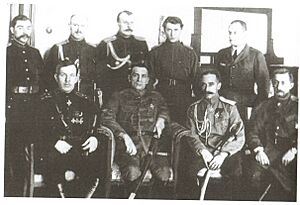
At first, Kolchak's White forces had some success. Kolchak was not used to fighting on land, so he let his generals handle most of the battle plans. His northern army captured Perm in late 1918. The White forces also took Ufa in March 1919 and moved towards Kazan and the Volga River. Anti-communist uprisings in other cities helped them. The Red Army often retreated, allowing the Whites to advance.
Kolchak's territories covered a large area and had about 7 million people. In April, the Bolsheviks decided that defeating Kolchak was their most important goal. But as the weather got warmer, Kolchak's situation got worse. His armies were too far from their supply lines, they were tired, and the Red Army brought in many new soldiers.
Kolchak also had problems with potential allies. The Czechoslovak Legion and the Polish 5th Rifle Division did not fully support him. The Japanese also feared he would interfere with their control of Far Eastern Russia, so they did not help him. The American troops in Siberia stayed neutral and only helped keep the Trans-Siberian railroad running. The American commander did not like Kolchak's government, seeing it as too strict and wanting to bring back the monarchy.
Defeat and Death
From 1919, the Bolshevik forces reorganized and began to push back against Kolchak. He quickly lost ground. The Red counter-attack started in late April. The fighting was intense, with both sides fighting hard. The Red Army captured Ufa in June, and by the end of that month, they broke through the Urals. Once out of the mountains, the Reds moved very quickly, capturing Chelyabinsk in July.
The White forces tried to hold a new line, but they kept losing soldiers. The Reds broke through again in October, and by November, the White forces were retreating in a disorganized way towards Omsk.
Kolchak also faced threats from within his own areas. Local opponents started to cause trouble, and international support for him began to decrease. Omsk was evacuated on November 14, and the Red Army took the city easily, capturing many supplies and soldiers. As people fled eastward, a disease called typhus became a serious problem.
Kolchak left Omsk on November 13 for Irkutsk by train. His train was on a section of track controlled by the Czechoslovaks. In December, his train was stopped. In late December, Irkutsk came under the control of a group that included Socialist-Revolutionaries. They decided to remove Kolchak from power. When he heard this on January 4, 1920, he resigned, giving his position to another general, Anton Denikin.
Kolchak was promised safe passage by the Czechoslovaks to the British military mission in Irkutsk. Instead, he was handed over to the new authorities in Irkutsk on January 14. On January 20, the government in Irkutsk gave power to a Bolshevik military committee. Kolchak was questioned for nine days. Even though an order came from Moscow to stop, Admiral Kolchak was sentenced to death along with his Prime Minister.
Both prisoners were brought before a firing squad on the night of February 6, 1920. Witnesses said Kolchak was calm and unafraid. He asked if a message could be sent to his wife in Paris to say he blessed his son. A priest then gave them their last rites. The squad fired, and both men fell. Their bodies were put under the ice of the frozen Angara River and were never found. When the White Army learned about the executions, they decided to retreat further east in what became known as the Great Siberian Ice March. The Red Army officially announced Kolchak's death on March 7.
Awards and Decorations
 Russian Empire:
Russian Empire:
 Cross of St. George, 3rd class (1919)
Cross of St. George, 3rd class (1919) Cross of St. George, 4th class (1915)
Cross of St. George, 4th class (1915) Order of Saint Anna, 1st class with swords (1917)
Order of Saint Anna, 1st class with swords (1917) Order of Saint Anna, 2nd class (1910)
Order of Saint Anna, 2nd class (1910) Order of Saint Anna, 4th class with the inscription "For Bravery" (1904)
Order of Saint Anna, 4th class with the inscription "For Bravery" (1904) Order of Saint Stanislaus, 1st class with swords (1916)
Order of Saint Stanislaus, 1st class with swords (1916) Order of Saint Stanislaus, 2nd class with swords (1905)
Order of Saint Stanislaus, 2nd class with swords (1905) Order of Saint Vladimir, 2nd class with swords (1905)
Order of Saint Vladimir, 2nd class with swords (1905) Order of Saint Vladimir, 3rd class with swords (1915)
Order of Saint Vladimir, 3rd class with swords (1915) Order of Saint Vladimir, 4th class with swords and bow (1907)
Order of Saint Vladimir, 4th class with swords and bow (1907) Saint George Gold Sword for Bravery, with inscription "For the defense in cases against the enemy near Port Arthur" (1905)
Saint George Gold Sword for Bravery, with inscription "For the defense in cases against the enemy near Port Arthur" (1905) Russo-Japanese War Medal (1906)
Russo-Japanese War Medal (1906) Medal "In commemoration of the reign of Emperor Alexander III" (1896)
Medal "In commemoration of the reign of Emperor Alexander III" (1896) Medal "In Commemoration of the 300th Anniversary of the Reign of the House of Romanov" (1913)
Medal "In Commemoration of the 300th Anniversary of the Reign of the House of Romanov" (1913) Medal "In Commemoration of the 200th Anniversary of the Naval Battle of Gangut" (1915)
Medal "In Commemoration of the 200th Anniversary of the Naval Battle of Gangut" (1915) Great Gold Constantine Medal by Imperial Russian Geographical Society (1906)
Great Gold Constantine Medal by Imperial Russian Geographical Society (1906) Port Arthur Cross (1914)
Port Arthur Cross (1914)
 French Third Republic:
French Third Republic:
 Officer of the Legion of Honour (1914)
Officer of the Legion of Honour (1914)
 British Empire:
British Empire:
 Knight Grand Cross of the Order of the Bath (1915)
Knight Grand Cross of the Order of the Bath (1915)
Legacy
Admiral Kolchak's time as "Supreme Ruler" was not successful. As a military commander, he struggled to make good plans or work well with other White Army generals.
Kolchak also couldn't convince Finland to join him against the Bolsheviks. No country in the world officially recognized his government, not even the United Kingdom, though they did support him with supplies. He also upset the Czechoslovak Legion, who were a strong military force against the Bolsheviks. The American commander, General Graves, did not like Kolchak and refused to give him any military help.
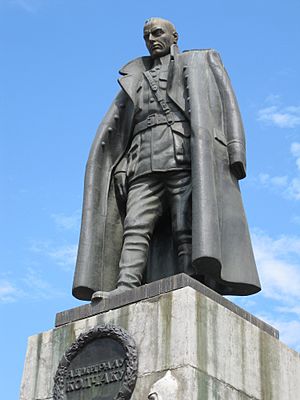
After many years of being seen as a villain by the Soviet government, Kolchak is now a debated historical figure in modern Russia. Some groups have tried to clear his name, but requests to officially restore his reputation have been denied by courts.
Monuments dedicated to Kolchak were built in Saint Petersburg in 2002 and in Irkutsk in 2004, even though some people were against them. His memorial in St. Petersburg is often targeted by vandals. There is also an island named Kolchak Island. The modern Russian Navy thought about naming a new ship "Admiral Kolchak" but decided not to.
Kolchak was an expert on naval mines and a member of the Russian Geographical Society. His awards include the Saint George Gold Sword for Bravery for his actions in the battle of Port Arthur, and the Great Gold Constantine Medal.
In Culture
A movie about Kolchak's life, called Admiral, was released in Russia in 2008. The film shows him as a tragic hero who deeply loved his country.
A special silver coin showing Admiral Kolchak has been made for collectors.
In a fictional alternate history called Ill Bethisad, the story changes because Kolchak's White Army wins the Russian Civil War.
See Also
 In Spanish: Aleksandr Kolchak para niños
In Spanish: Aleksandr Kolchak para niños
- Iliaș Colceag, an ancestor
Images for kids



